Author: Mia, ChainCatcher
With the emergence of OpenAI's video generation model Sora and Google's Gemini 1.5 Pro large model based on the MoE architecture, it has sparked a strong response in the global market.
However, the strong rise of AI giants such as OpenAI and Google has also raised public concerns about data privacy and security. How to continuously improve the deep learning capabilities of AI while ensuring the digital property rights of creators is a question that needs to be considered.
Thus, KIP Protocol, the first decentralized Web3 underlying protocol dedicated to AI, came into being.
KIP Protocol: Focusing on AI Security and Innovation in Web3 Underlying Protocol
In early 2024, "AI+Crypto" was included in a16z's "2024 Outlook List," emphasizing that encryption technology can "create a multilateral, global, permissionless market, where anyone can contribute computing or new datasets to a network in need and be compensated," and the long tail of resources will reduce the cost of AI and make data more accessible.
Vitalik Buterin also expressed his outlook on "AI+Crypto" in his article, similarly believing that encryption technology can balance the centralization and transparency of AI and help optimize AI data storage.
The goal of KIP Protocol is to develop a secure and efficient decentralized Web3 underlying protocol, enabling AI creators (data owners, model creators, AI application developers) to:
- Deploy their work on Web3 to retain complete digital property rights
- Interact and trade with other AI assets
- Earn income without losing access control
At the same time, KIP Protocol is also the world's first Web3 protocol to support decentralized RAG (Retrieval-Augmented Generation) solutions. The second article in its official Explainer series also focuses on introducing the RAG concept.
RAG is a complex innovative technology used in generative AI, allowing AI models to generate answers that they originally did not know by retrieving data and information from external knowledge bases and databases. It acts like an intelligent assistant, able to professionally find the answers you want from external data without exposing the data to the model to protect its security.
RAG technology involves three key value creators in AI (App developers, model creators, and data owners).
By establishing a decentralized RAG framework, KIP essentially establishes a decentralized framework for controlling AI value creation, providing a fair competitive environment for all value creators to break free from AI monopolies. It allows AI to operate efficiently, becoming the result of the collective efforts of millions of small and large-scale creators without the need for any large company to control every core function.
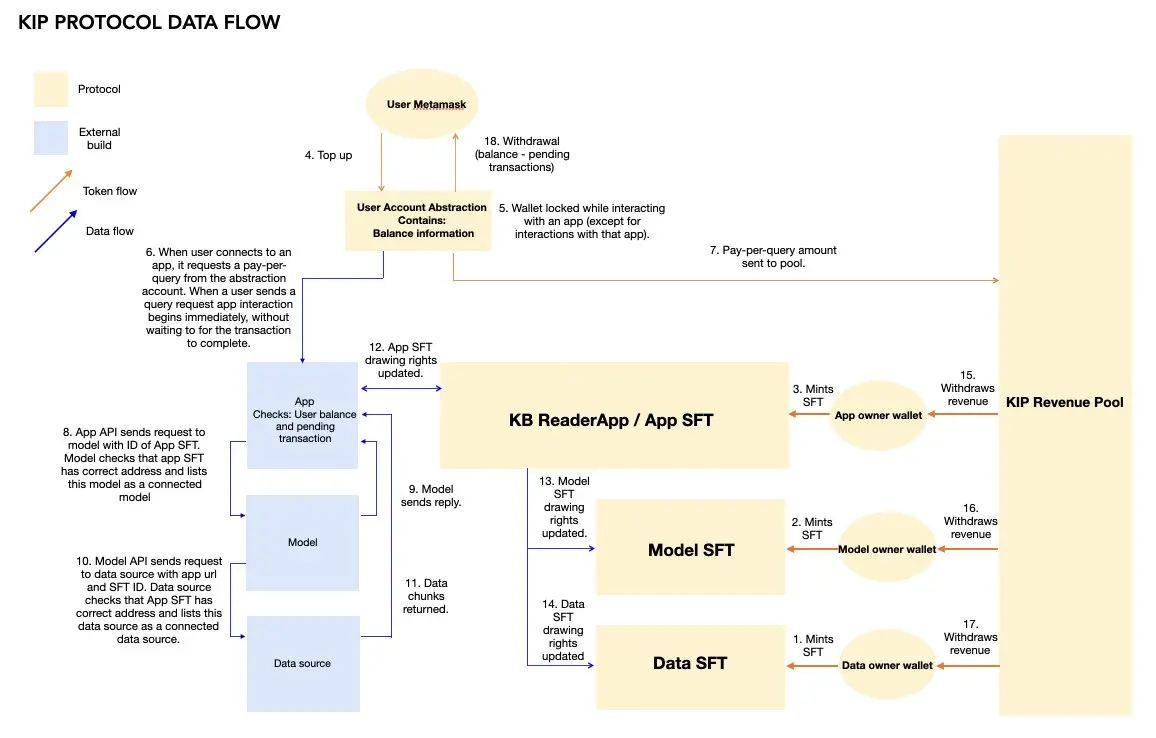
Recently, KIP Protocol announced a strategic round of financing led by Animoca Ventures. According to the official introduction, the KIP team has brought together senior doctors and technical experts dedicated to AI research since 2019, with deep professional backgrounds and rich experience in the Web3 field.
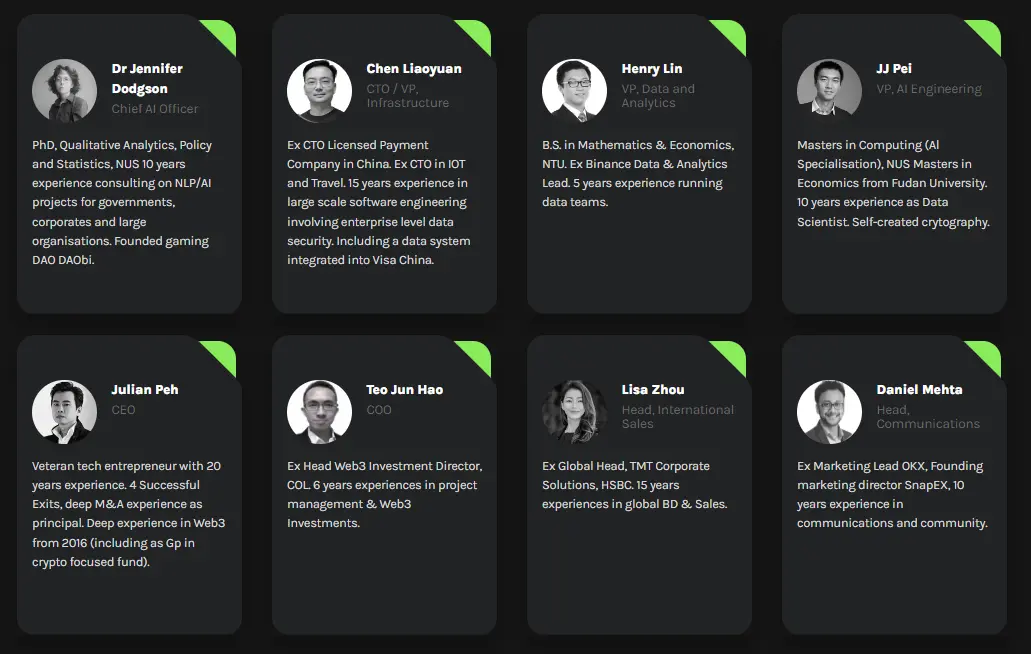
At the same time, the KIP Protocol team won the Tencent Cloud Award at the 2023 Chainlink Constellation Hackathon. Its first app on the protocol, "Kipley.ai," a security-centered multi-model RAG platform, has successfully cooperated with Animoca Ventures, Thailand Institute of Scientific and Technological Research, Anomaly, and many professors and researchers from well-known universities. The protocol's first dapp, "KnowledgeFi," as disclosed in its white paper, is also set to be launched in the first or second quarter of 2024.
Decentralization: The Inevitable Path for AI's Future
In the AI era, data and information support the operation of AI. The importance of data is self-evident, and only by forming a sufficiently large dataset can algorithm models be trained, ultimately bringing about economic effects. As the AI field develops, competitions to build the largest and most powerful models have begun, and "digital property monopoly" has become a focal point for major tech giants.
The original intention of KIP Protocol's construction is to protect the digital property of AI creators through Web3, providing a fair monetization path for every AI creator, building a diversified business ecosystem composed of different partners (data owners, model creators, AI application developers), and helping them achieve free cooperation or production creation based on KIP Protocol to break free from the growing AI monopolies of tech giants.
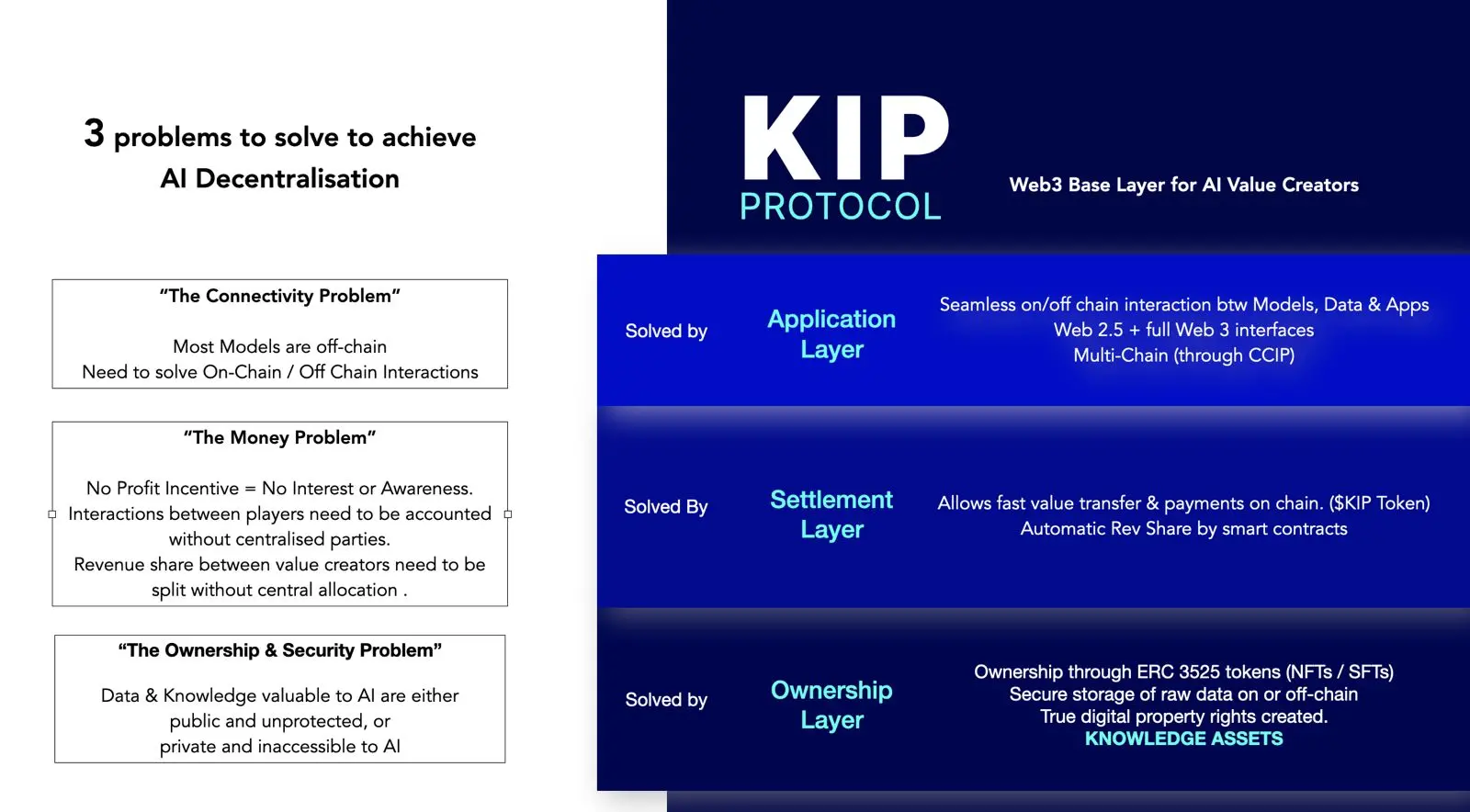
In this regard, KIP solves the three basic problems that AI model creators, app developers, and data owners will face when attempting to decentralize.
The Problem of "On-Chain and Off-Chain Data Interoperability"
With the continuous development of AI technology, the number of models on the open-source model library platform Hugging Face has exceeded 500,000. However, due to the current inability of blockchain technology to achieve complete decentralization, most AI models are still in the off-chain stage, while the application layer of KIP Protocol solves the interoperability problem between on-chain and off-chain.
Through the application layer, KIP can easily upload different assets (such as software, data, etc.) to the chain. AI applications can cast ERC-3525 SFT based on KIP Protocol, freely integrate and interact with AI models and data assets, and these interactions will be recorded on the chain through KIP Protocol. At the same time, AI application creators and users can choose which models, data, and application formats to use according to their needs.
The Problem of "Income Monetization"
The current basic income model in the AI field is pay-per-query, as each user query consumes the computing power of GPUs. Additionally, multiple AI value creators are needed to answer a user's query.
Therefore, for KIP Protocol, dedicated to decentralized AI, to succeed, it must ensure that all parties involved in decentralizing AI work can earn income.
However, this is not a simple matter in the AI field. Taking running queries through RAG (Retrieval-Augmented Generation) as an example:
- The user asks a question to an AI chatbot.
- The AI chatbot forwards the query to its "brain" - the AI model.
- The model retrieves the relevant data blocks needed to answer the question from the knowledge base, formulates the answer, and sends it back to the app.
- The app packages the answer and sends it to the user.
In this example, you can see how three roles contribute to answering user queries.
In a centralized ecosystem, if one platform owns and controls the three roles, users only need to pay this centralized platform, and the rest is internal transfers.
But if KIP Protocol wants to decentralize instead of monopolize, then each party needs to be paid. Therefore, the following problems need to be solved:
- Record (on-chain) the contributions of each person
- Allocate user income
- Allow everyone to earn their own income
Based on KIP Protocol, each creator can set their own price for the query function, and KIP will ensure that the fees paid by users are proportionally distributed to AI value creators (model creators, app developers, data owners).
Due to each interaction being recorded on the chain, KIP can accurately calculate AI interactions and earnings through a low gas, high-efficiency settlement layer, allowing each creator to realize income monetization while contributing to digital property rights.
"Digital Property Protection" Issue
KIP Protocol stores different assets (such as software, data, etc.) in the property layer of the KIP Protocol framework using blockchain tokens, especially in the form of ERC-3525 tokens (SFT).
For data owners: SFT represents a vectorized knowledge base or encrypted raw data file links used for model training.
For model creators: SFT can represent an API to off-chain models or a set of weight models available for sale.
For app developers: SFT can represent front-end APIs or prompts themselves.
These SFTs, as "monetizable entities," can interact with each other on-chain and record the amount each SFT earns from specific transactions.
By addressing these issues, KIP can enable AI value creators to easily achieve decentralization in their work, creating the initial conditions for a vibrant, larger decentralized AI ecosystem.
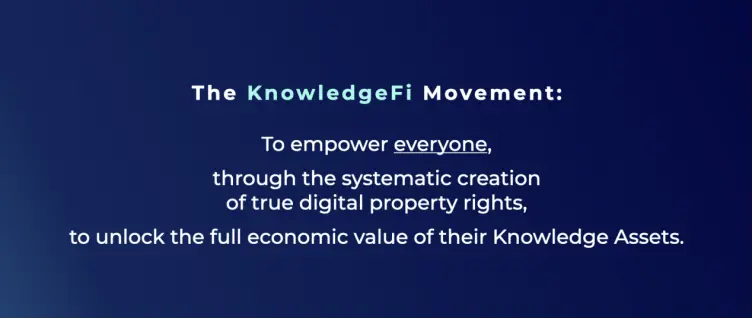
KIP Cycle in Progress, Overseas KOLs Endorse New Concepts of KIP
Currently, KIP has initiated multiple cycle activities on the X platform, with the 10th cycle just ending. Users need to unlock and complete tasks on Galxe to earn project points.
Speaking of points, this inevitably brings to mind the recent hot trend of "fair launch through points." Additionally, according to the KIP whitepaper, about 35% of the total supply will be used for the ecosystem fund, including community rewards based on "loyalty," so the so-called "airdrop expectations" are not unfounded. Moreover, with no large-scale market promotion, the total number of participants in the KIP Cycle has exceeded 50k, indicating good overseas popularity for the KIP project.

In fact, KIP has become a hot Alpha project in the eyes of crypto investors focusing on the AI sector.
Renowned BTC investment KOL Marco Johanning once stated on the X platform, "KIP is the first Web3 underlying protocol that supports decentralized AI RAG, and the project is still in its early stages." He also mentioned having contacted the KIP team, stating, "The KIP team only contacted some early investors of Bittensor because as $TAO Holders, they did not sell, but have common expectations for the AI sector."
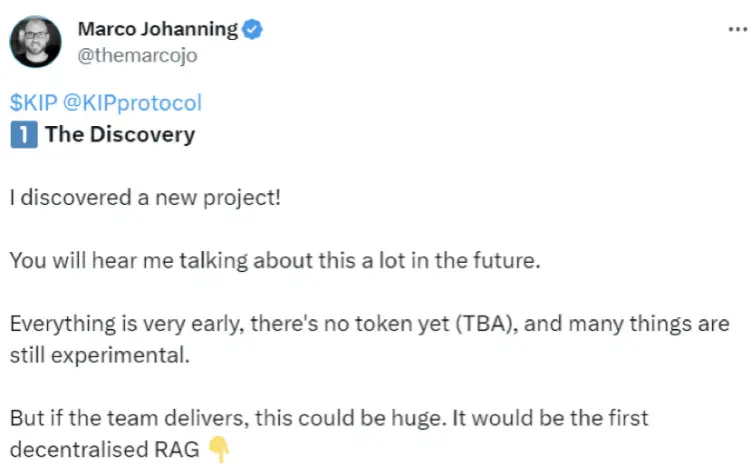
Crypto KOL AI Project Hub, deeply involved in the AI sector, described "KIP Protocol" as "decentralized AI research in a different way, which complements Bittensor (a protocol for decentralized incentivized machine learning intelligence production)."
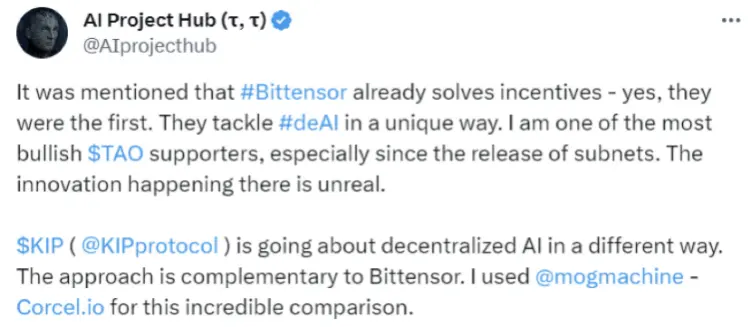
In response, another prominent overseas figure, Crypto Phoenix, commented on this article, expressing an open attitude and believing that the KIP project's launch was well thought out, especially regarding the redemption period and growth plan, and openly stated that KIP may achieve huge success in the future.

With nearly 50,000 followers, crypto influencer @wauwda also extended an olive branch to the KIP project, publicly stating participation in KIP's early financing.

Renowned crypto blogger Tomb has even listed KIP as the next potential wealth code.
Currently, overseas crypto investors in the AI sector are racing to be the "first crab eaters." However, compared to the lively and active overseas market, KIP's influence and visibility in the domestic market are still relatively blank, indicating unlimited potential and opportunities for domestic investors.
Based on the exchanges between the aforementioned KOLs and the team, we can deeply feel that this is a mature and visionary team, not only having a clear and definite plan for the development of KIP Protocol but also full of confidence and expectations for the future. This confidence and expectation are not unfounded but based on their deep understanding of AI and blockchain technology and solid technical strength.
In the view of the KIP team, the early user's choice is crucial, and they prefer to find those "long-term holders with an AI vision." Such a user base can not only bring stable and lasting support to the community but also form a strong consensus with the team to jointly promote the development of the KIP Protocol.
Conclusion
If "Crypto+AI=future of finance," then KIP may be a strong bet at the intersection of AI and the crypto field.
So far, in the "Crypto+AI" field, KIP is the first decentralized underlying protocol focused on AI. As an open-source Web3 underlying protocol, KIP Protocol has always upheld the value concept of "In the AI era, everyone should achieve KnowledgeFi," promoting the creation, management, and profitability of decentralized digital property rights to achieve KnowledgeFi. Recently, KIP Protocol announced its successful entry into Google Cloud's Startups Program, and the Dapp KnowledgeFi is set to be launched in the first or second quarter of this year.
The author believes that the "Crypto+AI" field is still a blue ocean market with tremendous potential, and paying attention to the development of early infrastructure is the first step in embracing the new wave. Although the future road of KIP is still long, the value concept and vision of KIP are spreading from the overseas community to the world.
About KIP Protocol
KIP Protocol builds a Web3 underlying protocol for AI app developers, model creators, and data owners, enabling AI assets to be easily deployed and monetized while retaining complete digital property rights.
KIP will create a brand-new AI business ecosystem to address the problems and challenges faced in decentralized AI deployment and ensure that everyone can enjoy the economic benefits brought by AI.
The KIP team has brought together senior doctors and technical experts dedicated to AI research since 2019, with deep professional backgrounds and rich experience in the Web3 field, committed to driving decentralized AI and accelerating the wave of decentralized AI.
For more information, please visit www.kip.pro or follow them on X @KIPProtocol.
免责声明:本文章仅代表作者个人观点,不代表本平台的立场和观点。本文章仅供信息分享,不构成对任何人的任何投资建议。用户与作者之间的任何争议,与本平台无关。如网页中刊载的文章或图片涉及侵权,请提供相关的权利证明和身份证明发送邮件到support@aicoin.com,本平台相关工作人员将会进行核查。




